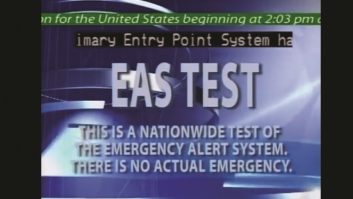
There are mixed early sentiments about the Federal Communication Commission’s new EAS reporting tool, with one reader telling Radio World the technology behind the commission’s emergency alert reporting system “remains broken.”
The EAS Testing Reporting System, which went live June 27, is designed to offer broadcasters a better mechanism for providing feedback on the effectiveness of nationwide emergency alert system tests. (The next such test will take place in September.)
New features within ETRS are designed to ease the data-entry burden on EAS participants, encourage timely filings and minimize input errors, the FCC says on its ETRS home page.
But a number of Radio World readers who have begun using the system — by registering within ETRS and filling out the initial Form 1 — have made note of issues they would like to see addressed.
Tom Taggart with Seven Ranges Radio in St. Marys, W.Va., feels the level of information required to weed your way through the system requires an in-depth engineering knowledge that may be beyond the capabilities of many small stations.
“The information required by Form 1 takes both some engineering knowledge and knowledge of the FCC’s databases,” he said. “It will be beyond the ability of [some] station personnel to complete.”
Add to that the intricacies of the initial registration process. One registrant was told by an FCC contact that he could expect the registration process for Forms 1, 2 and 3 in the ETRS database to take up to 43 hours, or more than a full business week of someone’s time. Radio World has not been able to verify or obtain FCC comment on that; but language in the Federal Register does say the “estimated time per response” is 43 hours, which appears to be how long it would take to complete the whole process. RW has a call into the FCC.
Before any actual reporting begins, EAS participants must register within the ETRS system and wait to receive account credentials. It’s important that broadcasters be precise with the information they enter, according to telecom law firm Fletcher, Heald & Hildreth. In a blog post soon after the ETRS system went live, attorney Harry Cole recommended that care be taken to accurately provide details such as the EAS participant’s legal name during the registration process, even if a station is owned by a larger entity.
Said Taggart with Seven Ranges Radio: “Contract engineers who handle several stations most likely won’t have the information to register (FRN and password) in the first place.”
Even a seasoned professional like Taggart had to call the commission regarding the instructions for entering information. “The instructions were not helpful,” he said. “For example, the request for the ‘geographic area’ was deciphered to mean the local area or region assigned under the state plan.” The coordinator whom Taggart reached by phone, however, was very helpful, he said.
Taggart also encountered problems with cookies — and not the sugary good kind.
“If you are doing Form 1 for several different companies, the system automatically opens back up on the first company entered,” he said. “You must then log out and renter the program to enter data for company two.” This can be accomplished by clicking on the name in the upper right corner, but “sometimes even this doesn’t work,” he said.
Law firm Fletcher, Heald & Hildreth did note that participants with multiple facilities can appoint an EAS coordinator who can access and revise data for all filers using the same FRN.
Some low-power FM stations are finding the process daunting. One reader felt the entire ETRS system was something of a switcheroo. “The FCC should have used an existing system like CDBS rather than ‘starting from scratch’ with new passwords, new user names, etc.,” said John O. Broomall, licensee of WPCG(LP) in Canton, Ga., and co-founder of the group Christian Community Broadcasters.
While certain fields are said to be auto-populated to ease the input process, that has not be the case for WPCG(LP). “You are expected to know not only the stations you monitor (no big deal), but the class of monitoree you are and what EAS region you are in.”
BJ Mora, licensee of station KGCE(LP) in Modesto, found the instructions clear enough, but isn’t sure he was accessing all the built in ‘widgets,’” he said: “My understanding was that a fair amount of information was supposed to prepopulate.”
Broomall concurred. “The auto-populate feature did not work for me or a fellow LPFMer in California,” he said, and said that most LPFMers may not know the answers to required questions such as a designed area or relay classification.
“The FCC needs to improve/change ETRS significantly,” Broomall said.
Mora’s primary suggestion for improving ETRS would be to have the entry of key data be more automatic, “unless the commission wanted manual entry as a failsafe/double check,” he said.
Taggart also wondered about some of the thought processes involved. “I question what the commission is up to here,” he said. “Supposedly the Sept. 28 test will be sent only through the CAP system. Hence, unless the station has no internet access, why does the commission need to know the radio stations monitored?
“Further, given the commission’s propensity for revenue enhancement, I fear potential for confusion where the state plan lists ‘monitoring assignments’ that include stations that would not normally be monitored — e.g. a Class C AM station, graveyard channel, 25 miles away,” he said. “The system also does not allow entry of other sources of monitoring such as state networks.”
Broomall also noted that the system issues multiple warnings that information must be accurate information or the registrant could face civil or criminal penalties. “There is no useful error-checker for such things as coordinates,” he said.
His real-world suggestions to the commission on improving ETRS? “Scrap it,” he said. “Set up EAS test reporting as a form within CDBS or possibly the new LMS (Licensing and Management System)
system.”
Radio World has reached out to the FCC for comment about this story.
Some state broadcast organizations have taken preemptive steps to help their broadcasters adhere with the new reporting system. The Alabama Broadcasters Association, for one, offered members step-by-step guidance on certain parts of the registration process via an email blast. It offered a direct link to the registration page and tips on filling out certain areas such as how to determine a station’s operational area, and a reminder that stations must complete Form 1 by Aug. 26.
That’s the date by which EAS participants must have completed the registration process and Form 1. Submitted Form 1 filings can be edited until Sept. 26. The next nationwide EAS test is scheduled for Sept. 28.
Those looking for information about or assistance with ETRS can contact the FCC at [email protected], or via Austin Randazzo, attorney advisor in the Policy and Licensing Division at 202-418-1462 or [email protected].
What is your experience with the new ETRS system? Email Radio World’s Susan Ashworth at [email protected].











